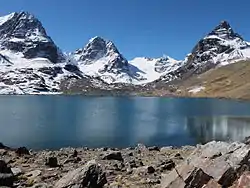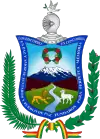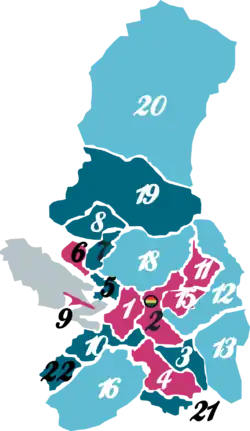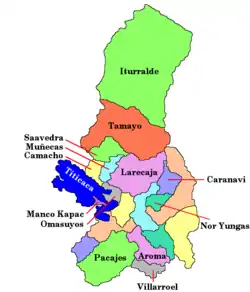La Paz Department (Bolivia)
The La Paz Department of Bolivia comprises 133,985 square kilometres (51,732 sq mi) with a 2012 census population of 2,706,359 inhabitants. It is situated at the western border of Bolivia, sharing Lake Titicaca with adjacent Peru. It contains the Cordillera Real, which reaches altitudes of 6.6 kilometers (4.1 mi). Northeast of the Cordillera Real are the Yungas, the steep eastern slopes of the Andes Mountains that make the transition to the Amazon River basin to the northeast. The capital of the department is the city of La Paz and is the administrative city and seat of government/national capital of Bolivia.
Department of La Paz | |
|---|---|
 | |
 Flag  Coat of arms | |
 Location of La Paz Department within Bolivia | |
 Provinces of the La Paz Department | |
| Country | |
| Capital | Nuestra Señora de La Paz |
| Government | |
| • Governor | Félix Patzi Paco |
| Area | |
| • Total | 133,985 km2 (51,732 sq mi) |
| Population (2012) | |
| • Total | 2,706,359 |
| • Density | 20/km2 (52/sq mi) |
| Time zone | UTC-4 (BOT) |
| HDI (2017) | 0.693[1] medium · 6th |
| Website | www |
Provinces
The Department of La Paz is divided into 20 provinces (provincias) which are further subdivided into 85 municipalities [2] (municipios) and - on the fourth level - into cantons.
The provinces with their capitals are:
| Province | Area km² | Population (2012 census) | Capital |
|---|---|---|---|
| Abel Iturralde | 42,815 | 18,073 | Ixiamas |
| Aroma | 4,510 | 97,364 | Sica Sica |
| Bautista Saavedra | 2,525 | 16,308 | Charazani |
| Caranavi | 3,400 | 59,365 | Caranavi |
| Eliodoro Camacho | 2,080 | 53,747 | Puerto Acosta |
| Franz Tamayo | 15,900 | 26,997 | Apolo |
| Gualberto Villarroel | 1,935 | 17,782 | San Pedro de Curahuara de Carangas |
| Ingavi | 5,410 | 134,535 | Viacha |
| Inquisivi | 6,430 | 66,346 | Inquisivi |
| José Manuel Pando | 1,976 | 7,381 | Santiago de Machaca |
| José Ramón Loayza | 3,370 | 47,295 | Luribay |
| Larecaja | 8,110 | 86,481 | Sorata |
| Los Andes | 1,658 | 77,579 | Pucarani |
| Manco Kapac | 367 | 27,154 | Copacabana |
| Muñecas | 4,965 | 29,694 | Chuma |
| Nor Yungas | 1,720 | 36,983 | Coroico |
| Omasuyos | 2,065 | 84,484 | Achacachi |
| Pacajes | 10,584 | 55,180 | Coro Coro |
| Pedro Domingo Murillo | 4,705 | 1,663,099 | Palca |
| Sud Yungas | 5,770 | 105,013 | Chulumani |
| Total: | 133,985 km² | 2,706,359 | |
| Note: More than 3,770 km² of Lake Titicaca |
Government
The chief executive office of Bolivia's departments (since May 2010) is the Governor; before then, the office was called the Prefect, and until 2006 the prefect was appointed by the President of Bolivia and then the governor is elected by the voters. The current governor, Félix Patzi Paco, was elected on 29 March 2015 and took office on 31 May.
Under the 2009 Constitution, Bolivian departments have an elected legislature, known as the Departmental Legislative Assembly. The La Paz Assembly has 45 members including five indigenous / natives minority representatives.
The most recent governor election results (2015) are as follows:[3]
| Candidate | Party | Votes | % | |
|---|---|---|---|---|
| Félix Patzi Paco | Sovereignty and Freedom | 673,244 | 50.09 | |
| Felipa Huanca Llupanqui | Movement for Socialism | 412,385 | 30.68 | |
| Elizabeth Reyes Limpias | National Unity Front | 108 509 | 8.07 | |
| Felipe Quispe Huanca | Movement for Sovereignty | 63 941 | 4.76 | |
| David Vargas Flores | Front for Victory | 52 527 | 3.91 | |
| Julio Tito Condori | Patriotic Social Alliance | 18 513 | 1.38 | |
| Hugo Sandoval Costas | Revolutionary Nationalist Movement | 14 866 | 1.11 | |
| Valid votes | 1,343,985 | 100% | ||
| Blank votes | 96,363 | |||
| Null votes | 64,329 | |||
| Total votes | 1,504,677 | |||
| Abstention | 195,539 | |||
| Registered voters | 1,700,216 | |||
| Source: Atlas of the Plurinational Electoral Body of Bolivia | ||||
Past executives
| Date Began | Date Ended | Prefect/Governor | Party | Notes |
|---|---|---|---|---|
| 23 Jan 2006 | 10 Aug 2008 | José Luís Paredes Muñoz | Social and Democratic Power | First elected prefect. Elected in Bolivian general election, December 2005, and removed by the 2008 recall election. |
| 12 Aug 2008 | 29 Aug 2008 | Alejandro Zapata (acting, de facto) | ||
| 29 Aug 2008 | 30 May 2010 | Pablo Ramos Sánchez (acting) | MAS-IPSP | Final prefect |
| 30 May 2010 | 31 May 2015 | César Hugo Cocarico Yana | MAS-IPSP | Elected in regional election on 4 April; first elected with the renamed title of governor |
| Source: worldstatesmen.org | ||||
Languages
The languages spoken in the department are mainly Spanish, Aymara, Quechua and Guaraní. The following table shows the number of people belonging to the recognized group of speakers. [4]
| Language | Department | Bolivia |
|---|---|---|
| Quechua | 158,260 | 2,281,198 |
| Aymara | 1,181,593 | 1,525,321 |
| Guaraní | 1,526 | 62,575 |
| Another native | 4,446 | 49,432 |
| Spanish | 1,973,708 | 6,821,626 |
| Foreign | 70,448 | 250,754 |
| Only native | 257,242 | 960,491 |
| Native and Spanish | 1,027,999 | 2,739,407 |
| Spanish and foreign | 946,650 | 4,115,751 |
Places of interest
References
- "Sub-national HDI - Area Database - Global Data Lab". hdi.globaldatalab.org. Retrieved 2018-09-13.
- www.bolivia.com (English)
- "Los partidos combinan perfiles para la Gobernación de La Paz". eju.tv. 24 February 2010. Retrieved 2 April 2019.
- obd.descentralizacion.gov.bo Archived 2009-02-18 at the Wayback Machine (Spanish)
External links
| Wikimedia Commons has media related to La Paz Department, Bolivia. |
| Wikisource has the text of a 1911 Encyclopædia Britannica article about La Paz Department. |
